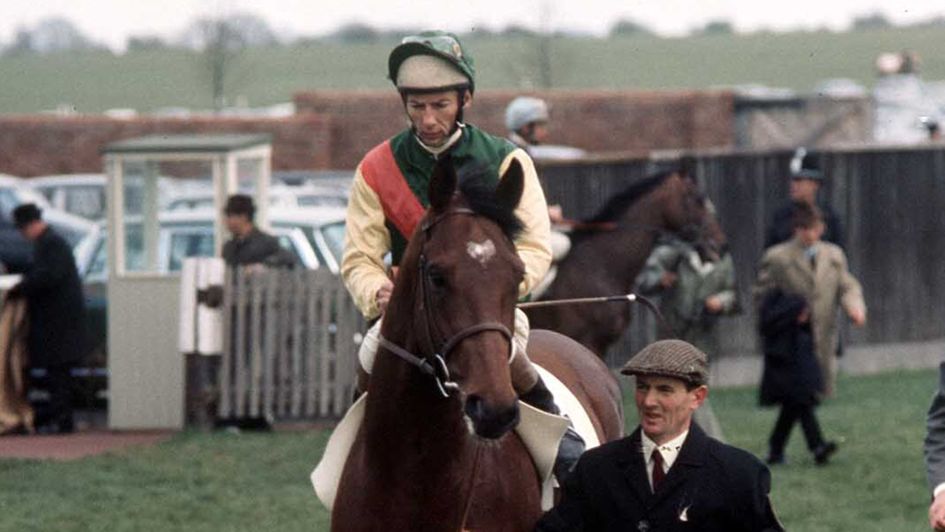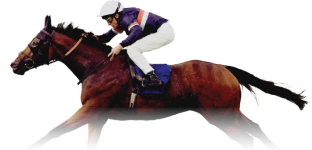Lester Piggott's record nine Derby winners spanned four decades. John Ingles covers them all from Never Say Die to Teenoso.
1954 NEVER SAY DIE (Timeform Annual rating 137)
Although six years had already passed since the first win of his legendary career, Lester Piggott was still only 18 when riding his first Derby winner, Never Say Die, making him the youngest jockey to win the race during the twentieth century.
This came just months after Piggott had ridden a winner, Mull Sack, at the National Hunt Meeting (nowadays the Cheltenham Festival) for his father after increasing weight in his teenage years had prompted a possible switch to riding over jumps. Beaten in all three of his races as a three-year-old prior to Epsom and with his jockey yet to make his mark on the race, at 33/1 Never Say Die was Piggott’s longest-priced Derby winner. In winning a shade comfortably by two lengths from Arabian Night, Never Say Die improved a stone on the pick of his previous form. ‘As Derbys go, it was a pretty simple race!’ recalled Piggott in his autobiography.
Never Say Die went on to win the St Leger but without Piggott in the saddle after he was hit with a six-month ban for causing interference when riding the same colt in the King Edward VII Stakes at Royal Ascot.
1957 CREPELLO (136)
In the autumn after riding his first Derby winner, Piggott joined the stable of Noel Murless at Warren Place who was to provide him with his second three years later. In contrast to Never Say Die, Crepello was sent off a hot favourite for the Derby at 6/4 having given Piggott his first success in the 2000 Guineas.
That could be said to have been a bonus because, as Racehorses put it, ‘Crepello was not only bred like a stayer; he looked like one, and galloped like one, and there seemed no doubt that he would stay much longer distances than a mile and a half.’ But being a big, heavy-topped colt, it was less certain that Crepello would handle the Epsom track, particularly on the prevailing firm ground.
He coped well enough to win, helped by avoiding trouble in running which others ran into, notably the third, Pipe of Peace. But Crepello’s size coupled with his races on firm ground ultimately took their toll as he never raced again after the Derby, ending any chance of his completing the triple crown (Derby runner-up Ballymoss went on to win the St Leger), though one of Piggott’s future Derby winners was to have better luck in that regard.
1960 ST PADDY (133)
Crepello’s owner Sir Victor Sassoon won the Derby four times in all and Piggott’s third winner St Paddy also carried the businessman’s colours. Incidentally, Piggott handled the owner’s Derby colts much better than he did the Lincoln Continental which Sassoon presented him with after Crepello’s win; he practically wrote it off soon afterwards running into the back of another car at a set of traffic lights in London!
Unlike Crepello, St Paddy didn’t have the speed for the 2000 Guineas but he was an impressive winner of the Dante Stakes next time and lined up as one of the main rivals to the favourite Angers at Epsom. But tragedy struck the French-trained colt when he broke a fetlock on the descent from Tattenham Corner whereas, once again, Piggott had his mount ideally placed to launch a challenge from just off the pace.
Sent about his business two furlongs out, St Paddy was kept going under just hands and heels for a decisive three-length win over Alcaeus who’d met bad interference coming down the hill. Providing some compensation for Crepello’s non-participation in the final classic, St Paddy ran out an easy five-length winner of the St Leger.
The same year, Piggott won the first of what were to be his eleven champion jockey titles.
1968 SIR IVOR (135)
By the time of Piggott’s fourth Derby winner he had turned freelance. His move from Warren Place was precipitated by choosing to ride Vincent O’Brien’s Valoris in the 1966 Oaks in preference to the Murless filly Varinia.
Putting loyalty to one side, Piggott simply believed Valoris had the better chance of winning – and he was proved right. But while the resulting loss of the stable jockey job at Warren Place cost Piggott another Derby winner in the short term when the Murless-trained Royal Palace was successful at Epsom in 1967, a year later the O’Brien-trained Sir Ivor provided Piggott with what he described as without doubt ‘the most exciting’ of all his nine Derby winners.
Although he had his stamina to prove, Sir Ivor was sent off the 4/5 favourite at Epsom after winning the 2000 Guineas with a turn of foot which gave him outstanding claims in the Derby if able to reproduce it over the much longer trip. He duly did so, finding what Racehorses called ‘a shattering turn of finishing speed to fly past the unfortunate Connaught’ inside the final furlong.
Ironically, the runner-up was trained by Murless. ‘Although others have strong claims to be called the best horse I ever rode’, said Piggott in his autobiography, ‘for me Sir Ivor stands above the rest.’
1970 NIJINSKY (138)
That was some compliment considering the Ballydoyle colt who came along just two years later. Nijinsky had the highest Timeform Annual rating among Piggott’s Derby winners.
Already unbeaten in five starts at two, winning the Dewhurst on the bridle on his first start outside Ireland, Nijinsky confirmed he was still the best of his generation when impressively landing the odds in the 2000 Guineas. The Derby was his greatest test yet, reflected in the fact that for the only time in his career he started at odds against – though still at only 11/8 – with the French colt Gyr considered his chief threat in a smaller than usual Derby field.
Gyr looked the likely winner when going clear two furlongs out but Piggott had his move covered and, without needing to come under the whip, Nijinsky came home two and a half lengths clear in a time just outside Mahmoud’s 1936 record.
After further wins in the King George VI & Queen Elizabeth Stakes and Irish Derby, Nijinsky was still unbeaten when completing the triple crown. Defeats in the Arc and Champion Stakes on his final two outings took little gloss off the record of a colt Piggott described as possessing ‘more natural ability than any horse I ever rode, before or since’.
1972 ROBERTO (131)
Not all of Piggott’s Derby victories came as easily as those on Sir Ivor and Nijinsky, and he had to work considerably harder to get Vincent O’Brien’s next winner of the race home in front.
Roberto’s main claim to fame came after Epsom when becoming the only horse to beat Brigadier Gerard in the Benson & Hedges Gold Cup at York when Piggott chose to ride the Derby runner-up Rheingold instead. There had been desperately little between the two colts at Epsom, Piggott’s renowned strength in the finish being the determining factor in making Roberto the short-head winner.
Piggott only got the ride on Roberto days before the Derby when the colt’s owner John Galbreath chose him to replace his original jockey Bill Williamson who, though passed fit, hadn’t ridden since injuring his shoulder in a fall ten days earlier. In a memorable finish, Roberto and Rheingold, who was hanging left down the camber, flashed passed the post together after exchanging several bumps in the closing stages.
Piggott initially thought Roberto had just been denied – he was therefore unsaddled on the track rather than in the famous winner’s enclosure - but fully expected to get the verdict in the inevitable stewards’ enquiry. But the photo revealed that Roberto had prevailed by a short head and he duly kept the race after lengthy deliberation by the stewards.
1976 EMPERY (128)
Whilst still a high-class colt, the French-trained Empery ranks as one of Piggott’s lesser Derby winners in terms of ability – the only other race he won was on his debut.
But in providing him with his seventh winner of the race, Empery’s win put Piggott in the history books as the Derby’s most successful jockey, a record he’d previously shared with the nineteenth century’s Jem Robinson and ten-times champion Steve Donoghue from earlier in the twentieth century.
Even Piggott himself, though, wasn’t confident of victory, his preview of the race in the Evening Standard appearing under the headline ‘I Think I’ll Need A Gun To Stop Wollow’. That was a reference to the hot favourite who’d won the 2000 Guineas.
Empery was first and foremost a stayer, and with that in mind Piggott gave him an ideal ride, never having him worse than fifth in the field of 23. Poised like Piggott’s other winners within striking distance of the leaders entering the straight, Empery held a better pitch than the unbeaten favourite.
While Wollow made good progress in the straight, it only took him into fifth behind Empery who kept on so well in the final furlong that he won convincingly in the end by three lengths.
1977 THE MINSTREL (135)
Lester had to be at his most persuasive again for the fourth and final Derby winner he rode for Vincent O’Brien on ‘what was probably the toughest horse I ever rode’.
A son of Northern Dancer, like Nijinsky, The Minstrel was also out of a half-sister to the triple crown winner. But whereas The Minstrel was unbeaten when winning the Dewhurst at two like Nijinsky, the flashy chestnut was turned over at short odds in the 2000 Guineas and was also beaten in the Irish equivalent before the Derby. Piggott’s name was therefore linked to several Derby candidates beforehand, including the French favourite Blushing Groom, but having persuaded his trainer to persevere with the Derby plan despite those defeats, Piggott took the ride on the Robert Sangster-owned colt.
Piggott adopted his usual position from which to strike – ‘the way he arrived there from the middle of the field was a joy to watch – beautifully balanced, no fuss, no check, no apparent effort from his jockey’ said Racehorses. But it took considerably more effort from the saddle in the last couple of furlongs for The Minstrel to wear down Willie Carson’s mount Hot Grove, Piggott getting him up by a neck in the shadow of the post.
1983 TEENOSO (132)
Very nearly thirty years after riding his first Derby winner in his teens, Piggott claimed his final Derby winner in trademark fashion on Teenoso.
Conditions were unusually soft for the 1983 Derby, so much so that overnight storms even put the meeting in doubt, but in what had been a very wet spring Teenoso had proven himself in the mud when winning the Lingfield Derby Trial. Once Piggott was booked for the ride, Teenoso was backed down to start the 9/2 favourite, and came home three lengths clear after setting sail for home early in the straight.
‘Lester Piggott demonstrated yet again why there is always a clamour for his services, particularly in the big races – and especially on Derby Day’ said Racehorses. ‘He seems somehow to grow neither older nor less effective as the years go by – Teenoso was his thirtieth ride in the Derby – and his mastery of the Derby course in particular is complete.
His great strength, demonstrated so effectively on Roberto and The Minstrel at Epsom, wasn’t called into play in 1983 but his handling of Teenoso was an object lesson in how to ride a proven stayer in the Derby. Piggott’s contribution to racing has been colossal and his place in the sport’s Hall of Fame is secure.’









